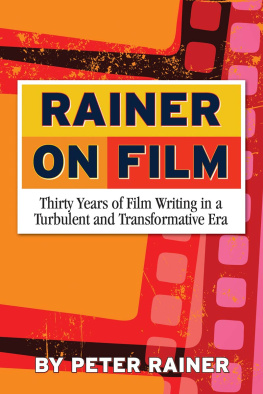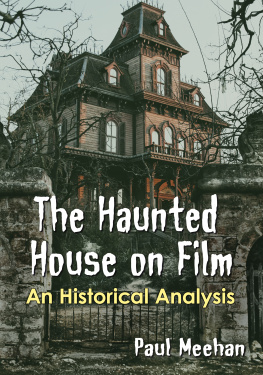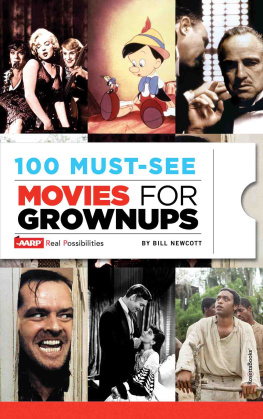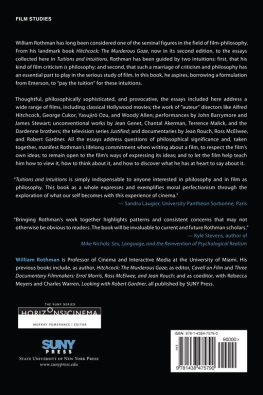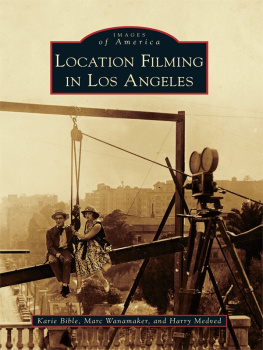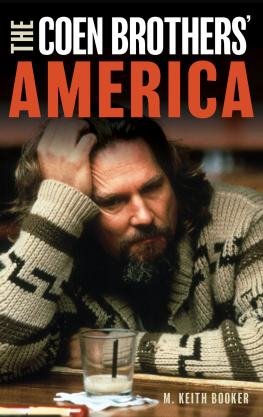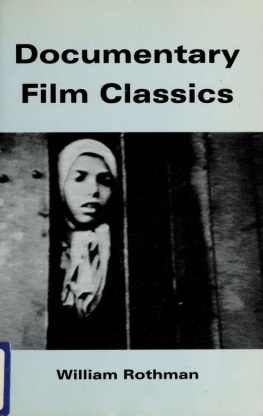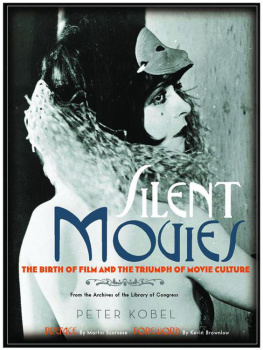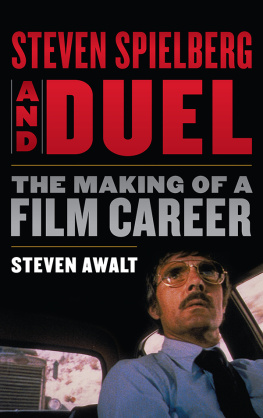
Copyright 2013 by Peter Rainer
All rights reserved.
This book may not be reproduced in whole or in part or in any form or format without the written permission of the publisher.
Published by:
 | Santa Monica Press LLC
P.O. Box 850
Solana Beach, CA 92075
1-800-784-9553 |
www.santamonicapress.com
Printed in the United States
Santa Monica Press books are available at special quantity discounts when purchased in bulk by corporations, organizations, or groups. Please call our Special Sales department at 1-800-784-9553.
ISBN-13 978-1-59580-077-0
Library of Congress Cataloging-in-Publication Data
Rainer, Peter, 1951
[Works. Selections.]
Rainer on film : thirty years of film writing in a turbulent and transformative era / by Peter Rainer.
pages cm
ISBN 978-1-59580-077-0 (pbk.)
1. Motion pictures. 2. Motion picturesReviews. I. Title.
PN1995.R27 2013
791.4375dc23
2013002641
Cover design by Future Studio
Back cover photo: Mary Knox Merrill/The Christian Science Monitor
For my parents, John and Barbara Rainer
CONTENTS
CHAPTER 1
OVERRATED, UNDERSEEN
CHAPTER 2
YOUNGISH TURKS
CHAPTER 3
AUTEURS
CHAPTER 4
STEVEN SPIELBERG
CHAPTER 5
ABOUT ACTING, STAR ACTORS, AND ACTING STARS
CHAPTER 6
SOME MASTERPIECES
CHAPTER 8
ISSUES (MOSTLY HOT-BUTTON)
CHAPTER 9
COMEDIES (INTENTIONAL AND UNINTENTIONAL)
CHAPTER 10
LITERARY AND THEATRICAL ADAPTATIONS
CHAPTER 11
MISCELLANY: BOOK REVIEWS AND CRUISE SHIPS
INTRODUCTION
S ome of my very first memories are of movies. My hazy recollection of Kirk Douglas and the giant squid in 20,000 Leagues Under the Sea may not qualify as Jungian or Freudian or primal or prelapsarian, but it tells me that movie love is bred in the bone. I suspect this is true for most people who care about movies.
I started watching them regularly when I around six or seven, on the New York TV show Million Dollar Movie, which replayed the same film over and over throughout the week. The show always opened with Max Steiners soaring theme from Gone with the Wind, which initially proved confusing when I finally saw Gone with the Wind. I am convinced that Million Dollar Movie set an entire crop of kids on the road to a critics connoisseurship. By weeks end, you could just about memorize how a movie was put together, whether it was The Hunchback of Notre Dame with Charles Laughton or The Body Snatchers with Boris Karloff. I fashioned a pantheon and peopled it with my own roster of stars.
Bogart was, for many years, chief luminary. He wasnt just a tough guya prerequisite for me in those dayshe was a tough guy with a cruel and curdling humor. He came wreathed in cigarette smoke that was like Hollywood hellfire. His wily, insinuating baritone, which could rise suddenly to a maniacs crescendo, was the obbligato of my pulp fantasies.
Around this time, in the mid-sixties, my father bought me a copy of Agee on Film, which had recently come out in paperback. This book remains for me the most rapturous of discoveries. The impassioned way Agee wrote about movies, including many of the forties Bogart films, legitimized my time in the dark (as, later, he helped legitimize my desire to become a critic). I would set my alarm clock so I could watch as many Agee-anointed films as possible on The Late Late Show: The Story of G. I. Joe, Hail the Conquering Hero, The Best Years of Our Lives, and The Treasure of Sierra Madre (again and again). The experience of watching films like these in the dead of night had an illicit tingle. It made me feel as if I were part of a secret society, and sure enough, in the years ahead, I met many other supplicants of the sectan entire film generation of them. I became a fixture at the New York revival houses and film societies. Hallowed ground for me was the Bleecker Street Cinema, where a typical double bill might be La Grande Illusion and Un Chien Andalou; the New Yorker on Broadway and Eighty-Eighth Street, where I first saw Citizen Kane and freaked out at Freaks; and, close by, the Thalia, which sloped upward and gave many a vagrant trying to sleep it off his first taste of Fellini.
The New Yorker had a massive wall of directors head shots in the lobby, a murderers row of mugs (Dovzhenko, Dreyer, Huston, Hitchcock ad gloriam). Inside the theaters low-lit entryway was a big, ledger-like book where you could write down screening recommendations. I would puzzle through other peoples wish lists, poring over the pages as if they were leaves in an illuminated manuscript. Not enough is made, I think, of the replenishing role that movie theaters play in the whole tone of a movie lovers experience. At least this was true before Twitterized patrons crammed the cubicles of the fifteen-plexes.
Back then, paradise was seeing Dr. No and Potemkin on the same day. I loved the way movies could reach high and low. This was, after all, a time when students were still required to memorize Joyce Kilmers Trees. Movies were a splendid rebuke. Pauline Kaels first collection, I Lost It at the Movies, came out around this time, and the elegant row-diness of her writing, her high-lowness, was unlike anything else; plus, unlike Agees, her reviews were for the most part about the fairly recent movie scene, which made their immediacy even greater for me.
I read Dwight Macdonald religiously in Esquire. I loved biblical epicsthis was, as a critic friend of mine describes it, my Pre-Taste Periodand Macdonald left them flapping in the wind (his takedown of The Greatest Story Ever Told is officially the Funniest Review Ever Written.) Manny Farbers essays, which were later collected in Negative Space, laid bare a strange and beautiful mindscape, brambly as hell. The pile-on of pronouncements continued with such critics as Stanley Kauffmann (still very much at it, illustriously, in his nineties), John Simon, and Andrew Sarris, whom I recognized as a kindred obsessive list-maker. None of these critics seemed to agree with each other on much of anything. The free-for-all was exhilarating, and also somewhat perplexing. I was accustomed to canons. By the time I entered college, I was pretty sure I wanted to be a film critic. I wanted to be in the cult. I wanted to try out my ideas in print and see if I could progress from idiot savant to savant.
For three years in the early seventiesbetween anti-war rallies and other extracurricular frolicsI was the chief critic for my college newspaper, the Brandeis Justice. I also helped program the college film society. I would bound onstage, offer bumbling preambles about mise en scne, and then signal the projectionist to start up Ugetsu. My audience, both in print and in the screening rooms, was captive. Films were much more central to the zeitgeist then, and the best of them were much better. I could write about Five Easy Pieces, or McCabe and Mrs. Miller, or Straw Dogs, or The Godfather, and the Justice would be dumped in bundles in front of the student union building and the reviews would be hashed out that day in the dining halls and dorms. My professors would argue with me about what I wrote. There was a marvelous urgency to all this, and my experience was not atypical. The big reason so many movie critics came out of my generation is that we all passed through the same ether.
Next page
